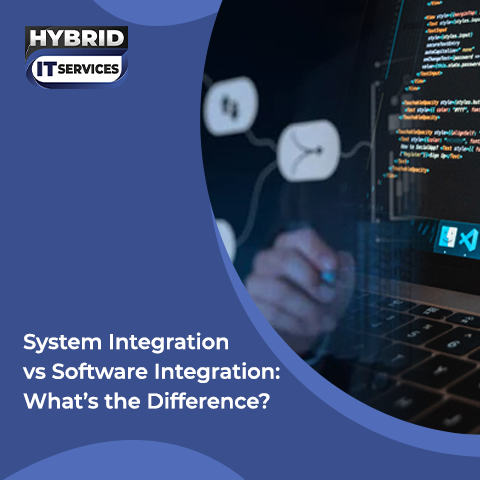When selecting software solutions, companies often face a crucial decision: whether to opt for off-the-shelf software or invest in custom software development. Each option has its own set of advantages and disadvantages, and the right choice depends on various factors. Each option includes the specific needs of the business, budget, and long-term goals. At Hybrid IT Services let's explore these two approaches in detail to help you make an informed decision.
Understanding Off-the-Shelf Software Solutions
Off-the-shelf software, also known as packaged or ready-made software, is a pre-built application developed for mass-market use. It is designed to cater to a wide range of users and is typically sold or licensed commercially. This type of software is readily available for purchase and can be quickly implemented within an organization.
Benefits of Choosing Off-the-Shelf Software
Cost-Effective: Off-the-shelf software is generally more affordable than custom solutions because the development costs are spread across many users. This makes it a viable option for small to medium-sized businesses with limited budgets.
Quick Deployment: Since off-the-shelf software is pre-built and tested, it can be implemented rapidly. This is particularly advantageous for businesses that need to address immediate operational needs.
Regular Updates and Support: Vendors of off-the-shelf software often provide regular updates, bug fixes, and support. This ensures that the software remains up-to-date with the latest features and security standards.
Wide Range of Features: Many off-the-shelf solutions come with a broad array of features and functionalities that cater to general business needs, reducing the need for additional tools or software.
Limitations of Off-the-Shelf Software
Limited Customization: Off-the-shelf software is designed for a broad audience, which means it may not fully align with the unique processes and requirements of a specific business. Customization options are often limited, which can lead to inefficiencies.
Scalability Issues: As a business grows, its needs may evolve beyond the capabilities of the off-the-shelf software. Scaling the software to accommodate increased usage or additional features can be challenging.
Potential Overhead Costs: While the initial cost may be lower, off-the-shelf software can incur additional costs for licenses, subscriptions, and mandatory updates, which can add up over time.
Dependence on Vendor: Users of off-the-shelf software are dependent on the vendor for updates, support, and new features. If the vendor discontinues the product or fails to provide adequate support, it can disrupt business operations.
Examples of Off-the-Shelf Software Solutions
Microsoft Office Suite: A widely used suite of productivity tools including Word, Excel, and PowerPoint.
Adobe Creative Cloud: A collection of graphic design, video editing, and web development applications.
QuickBooks: An accounting software designed for small and medium-sized businesses.
Salesforce: A comprehensive customer relationship management (CRM) platform.
What is Custom Software?
Custom software, also known as bespoke software, is tailored specifically to meet the unique needs of a particular organization. Unlike off-the-shelf software, which is designed for a broad audience, custom software is built from the ground up to align with the specific processes, goals, and challenges of a business.
Steps in Developing Custom Software
- Requirement Analysis: The process begins with a detailed analysis of the business's needs, goals, and challenges. This step is crucial for defining the scope and objectives of the software.
- Design and Planning: Based on the requirements, a detailed design and development plan is created. This includes defining the software architecture, user interface, and feature set.
- Development: The actual coding and development of the software take place during this phase. It involves creating the software components, integrating them, and ensuring they work seamlessly together.
- Testing and Quality Assurance: Before deployment, the software undergoes rigorous testing to identify and fix any bugs or issues. This ensures that the software is reliable, secure, and performs as expected.
- Deployment and Integration: Once the software is thoroughly tested, it is deployed and integrated into the existing IT infrastructure of the business.
- Maintenance and Support: Post-deployment, the software requires ongoing maintenance and support to address any issues, provide updates, and add new features as needed.
You May Also Read This Article For Details on this Topic: Why Your Business Needs Custom Software Development?
Benefits of Custom Software Development
Tailored Solutions: Custom software is designed specifically to meet the unique requirements of a business. This ensures that the software aligns perfectly with the company's workflows, processes, and goals.
Scalability: Custom software can be easily scaled and modified as the business grows and evolves. This flexibility allows businesses to adapt to changing needs and market conditions.
Competitive Advantage: By providing features and functionalities unique to the business, custom software can give companies a competitive edge in their industry.
Integration: Custom software can be designed to integrate seamlessly with existing systems and applications, ensuring smooth data flow and operational efficiency.
Challenges of Custom Software Solutions
Higher Initial Cost: The development of custom software can be expensive, as it involves creating a solution from scratch. This requires significant investment in terms of time and resources.
Longer Development Time: Developing custom software is a time-consuming process, often taking several months or even years, depending on the complexity of the project.
Ongoing Maintenance: Custom software requires ongoing maintenance and support, which can be costly and resource-intensive. Businesses must be prepared for this long-term commitment.
Risk of Project Failure: There is a risk that the custom software project may not meet its objectives, either due to miscommunication, changing requirements, or technical challenges.
Custom Software Examples
- Enterprise Resource Planning (ERP) Systems: Custom ERP systems are developed to manage and integrate various business processes, such as finance, human resources, and supply chain management.
- Customer Relationship Management (CRM) Systems: Custom CRM systems are designed to manage customer interactions, sales, and service processes tailored to specific business needs.
- E-commerce Platforms: Custom-built e-commerce platforms can offer unique shopping experiences, payment gateways, and inventory management tailored to the business model.
- Healthcare Management Systems: Custom healthcare software can include patient management, electronic health records, and appointment scheduling tailored to healthcare providers' specific needs.
Hybrid IT: A Right Choice for Custom Software Development in Arizona
For businesses in Arizona looking for a reliable partner in custom software development, Hybrid IT offers a compelling solution. Specializing in creating tailored software solutions, Hybrid IT understands the unique challenges and opportunities that businesses face. Their expertise spans across various industries, ensuring that the software developed is not only technically robust but also strategically aligned with business goals.
Conclusion
Ultimately, the decision should be based on a thorough assessment of the specific requirements and future goals of the business. For businesses seeking a unique solution that provides a competitive edge, custom software development. Particularly with experienced partners like Hybrid IT Services, can be the right choice. However, for those needing a more immediate, cost-effective solution, off-the-shelf software may be the best fit. Whatever the choice, the goal is to select a software solution that enhances operational efficiency and supports business growth.






